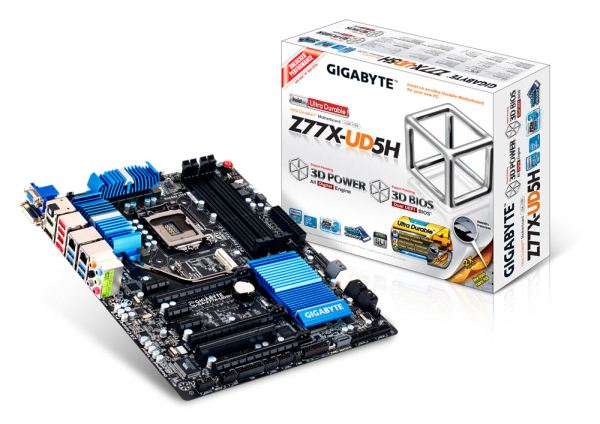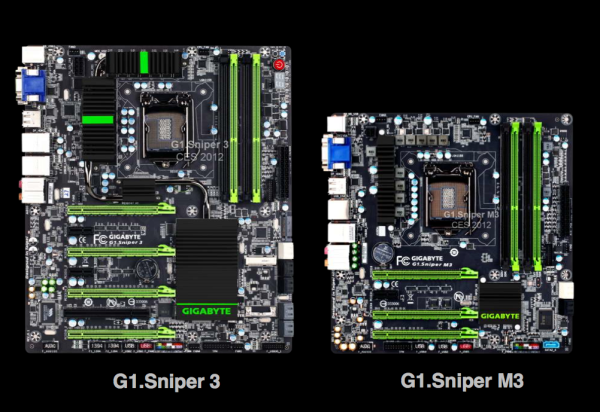A Brief Look at Some Upcoming 7-Series Motherboards
by Ian Cutress on March 9, 2012 5:00 PM EST- Posted in
- Motherboards
- Intel
- H77
- Z77
Gigabyte
Whenever a new chipset comes out, Gigabyte tend to do one of two things – either release a few boards to cover particular price points (usually models from UD3 to UD7), or release more than 10 or even 20+ products for the chipset. This latter method of attacking the market could perhaps overwhelm users into deciding which model to purchase, or that reviews could end up with so many boards to review it is hard to decipher which are the important ones. Nevertheless, Gigabyte for the 7-series launch has decided to attack the market with the latter, in the following models:
Gigabyte G1.Sniper 3
Gigabyte G1.Sniper M3
Gigabyte GA-Z77X-UD5H Wifi
Gigabyte GA-Z77X-UD5H
Gigabyte GA-Z77X-UD3H Wifi
Gigabyte GA-Z77X-UD3H
Gigabyte GA-Z77X-D3H
Gigabyte GA-Z77-D3H
Gigabyte GA-Z77-DS3H
Gigabyte GA-Z77MX-D3H
Gigabyte GA-Z77M-D3H
Gigabyte GA-H77-DS3H
Gigabyte GA-H77M-D3H
Gigabyte GA-B75M-D3H
Gigabyte GA-B75M-D3V
‘D’ means ‘All solid capacitor design’
‘U’ means ‘Double copper PCB design’
My guess is that this list is by no means complete, exhaustive or final (and perhaps includes models for sale in other parts of the world). No doubt we will see a UD4/UD4H, all the way up to UD7 as well. Gigabyte does have a microsite dedicated to their 7-series products, which does provide an informative list of what should be on offer.
The main features Gigabyte is going to be advertising with their 7-series launch is the almost ubiquitous placing of mSATA connectors on most of their boards, and that the UD3 and above boards come with wifi cards.
Gigabyte GA-Z77X-UD5H
Almost at the top of Gigabyte’s range at release is the GA-Z77X-UD5H. We see that the placement of the mSATA port is just below the CPU, which in the grand scheme of things should be ok as long as the user never wants to remove it (I can just imagine it being relatively stressful to take it out when a system is built and in a case). Also, all the boards in the range have both D-Sub and DVI outputs on the IO, which means on some models that they take up space for any PS/2 ports. This is despite the UD5H still sporting a PCI slot for legacy, even if it is taken up if a second dual slot GPU is used. As always, all Gigabyte models should support TPM, and in the case of the UD5, we have extra SATA ports and dual USB 3.0 headers onboard – all of which would be obscured by a full length third GPU.
G1.Sniper 3 and G1.Sniper M3
If we go back all the way to CES this year, Anand caught glimpse of the G1.Sniper series that Gigabyte had on display:
Given what we know about the Gigabyte range, we have some features to point out – if you want mSATA, it looks like you have to invest in a full size ATX style board. Unfortunately, that also means investing in a board that uses a PLX chip to give 4-way x8 performance for multi-GPU setups. Both boards seem to have specialized capacitors to deal with their audio solutions, which on the Gigabyte microsite states is the Creative Sound Core 3D – which is a step in a positive direction from normal Realtek audio solutions.


















55 Comments
View All Comments
shatteredx - Monday, March 19, 2012 - link
Lovin to see wifi on the asus boards. That's a bigger selling point for me than dual nics. Actually, can someone explain to me why you would want dual nics?tkafafi - Tuesday, March 20, 2012 - link
Why do the new intel chipsets (series 7) still contain so many (10) usb2 ports ? Would any PC/laptop manufacturer chose to use a usb2 port instead of anavailable usb3 port from the chipset ? for e.g would they use 2 usb2 + 2usb3 instead of 4 usb3 from the chipset ?I know PC manufacturers are using this configuration (2 usb2 + 2 usb3) because now they need to support usb3 through an external controller so they are saving cost by using a 2 port controller. But once series 7 chipsets arrive with native usb3 support, there would be no cost advantage to do this. Is this to derisk any interoperability issues with older usb2 devices (i.e if for some reason usb3 ports don't work well with some existing usb2 devices) ?
Thanks
ajeto - Saturday, May 26, 2012 - link
Does any of you guys (or girls) know what is the maximum resolution you can get when you use two displays on integrated graphic ASUS P8Z77-V LE?I'm planning to use one 30" and one 24"
I know that max 2560x1600 can only be achieved via DisplayPort so i was planning to get an Active DisplayPort to DVI-D converter...
Do you think it would work to get 2560x1600 and 1900x1200 simultaneously on my displays?
Thank you for any kind of info
ajeto - Sunday, May 27, 2012 - link
Yes multiple displays are working (two at least, that i've tried), BUT i only get max 1280x800 on 30" via DVI. This should be 1900x1200 as stated in specifications.The other (24") display is working at correct 1900x1200 (via HDMI)
Oh yeah, I forgot to mention i am using i5 3570K
ajeto - Sunday, May 27, 2012 - link
Funny that it works fine on two 24" @ 1900x1200, but if i use 30" i can only get 1280x800 as max on 30" and 1900x1200 on 24"I also tested this and it works:
30" on 8600GT @2560x1600
24" on integrated @ 1900x1200 (HDMI)
and even additional (which i connected just for testing purpose and i wont be using it)
24" on integrated @1900x1200 (DVI or VGA)
but the thing is i would really like to get rid of 8600GT and use just integrated graphics (no need for 3D accel) so that's why i wanted to buy Dell-BizLink-DisplayPort-Adapter-Powered to use DisplayPort on MoBo.
But since i only get 1280x800 from DVI to my 30" i'm kinda afraid it might not work even with DisplayPort ... :(
Any ideas/solutions greatly appreciated..